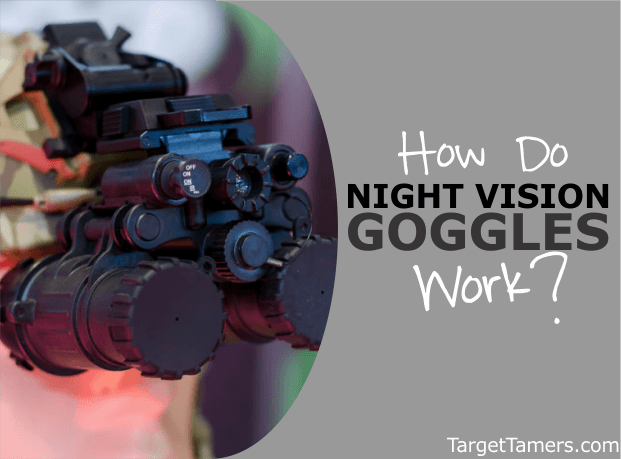
There are a lot of myths about night vision performance that have stemmed from the filming industry to past experiences of our veterans.
Night vision has come a long way since its day of conception.
As a result, the quality of night vision goggles available to both military and civilians are a lot more advanced and cheaper than what they used to be.
To understand the technology, you must know the facts.
Here is our take on separating fact from fiction in regards to correctly identifying night vision goggles, how night vision goggles work, and common goggle grumbles.
What are Night Vision Goggles?
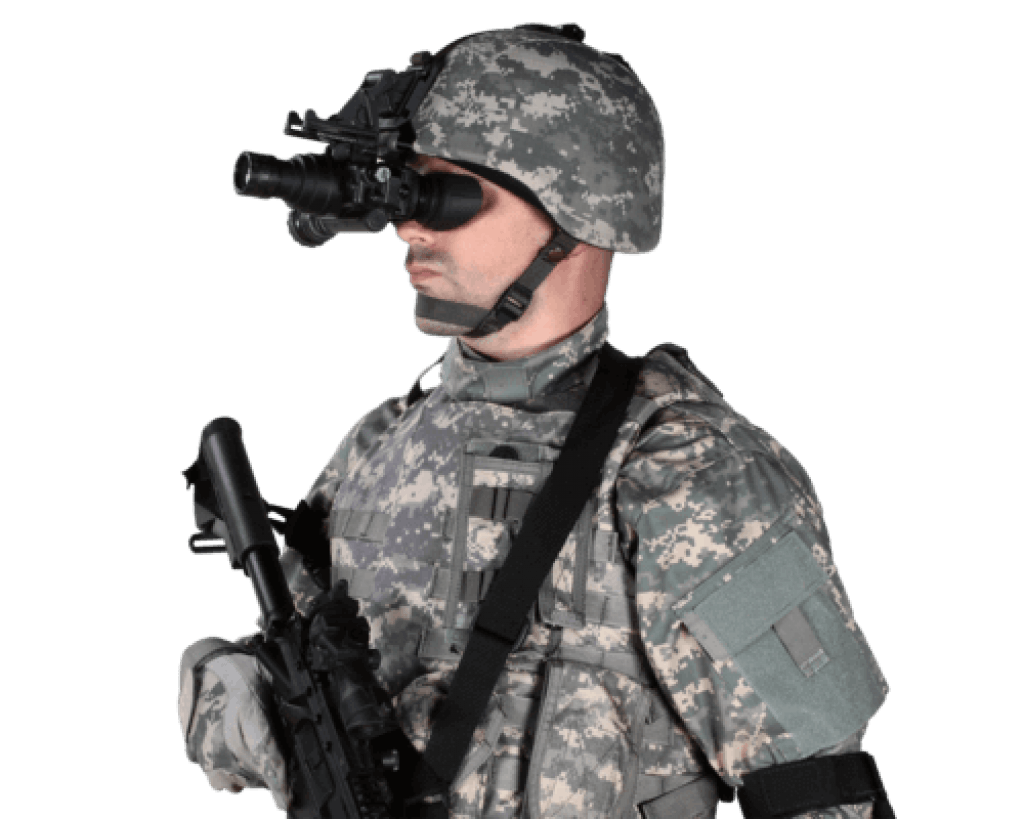
Did you know that not all night vision goggles are the same?
There are thermal imaging goggles and image enhancement night vision goggles.
Thermal is excellent for range and target identification via heat signatures. Image enhancement, aka night vision, is what we will be discussing as it requires ambient light to operate.
To compare the two technologies, check out this NV VS Thermal comparison guide.
The term “goggles” is really a catch-all term for any optic that’s head-mounted, for example, binoculars, bioculars, and even use of a monocular. But they are true goggles if they meet certain specs that allow them to be used in such a way as goggles are designed to operate.
You can recognize goggles by a few, easy-to-identify features:
- 1x magnification
- 20-29mm objective lens sizes (apertures)
- Must be designed for hands-free operation
- Includes head-mounting gear
Why is this distinction important?
True 1x performance is essentially no magnification, and it is vital to mobility, natural vision, and depth perception with use of night vision devices (NVD). The small apertures allow for wide fields of view. Both these specs also allow for a lightweight and compact optic that makes it easier to wear when mounted to the head/helmet.
Without the ability to allow for hands-free operation, it’s just another monocular, biocular, or binocular – they ain’t goggles.
For an in-depth investigation on the differences between night vision goggles and night vision binoculars, scope out our explanation here.
Part I: How Do Night Vision Goggles Work?
An NVD is capable of seeing light that the human eye cannot detect, and this includes ultra-violet and near-infrared wavelengths.
With technology that is capable of amplifying these undetectable lightwaves combined with what we can see with human vision (the visible light spectrum), we are able to see in the dark.
Essentially, night vision technology works to amplify those light signals using electronics. Those signals are boosted, and the end result is a recreated image of the scene with a green glow as seen on the display.
How Night Vision Works
To get technical, let’s break it down in layman’s terms.
- The main component in an NVD is the image intensifier tube (IIT). There are multiple components in an IIT that allow you to see in the dark.
- Primary components include a photocathode, microchannel plate (MCP), and phosphor screen.
- Light is made up of photons.
- Light enters the goggles via the objective lens.
- It strikes the next surface which is the photocathode, and electrons are released as a result.
- The electrons are boosted towards the MCP.
- At the MCP, the electrons are multiplied by the thousands.
- These electrons are again boosted and accelerate towards the phosphor screen.
- At the phosphor screen each electron is converted into a photon – back to light.
- The photons are focused by the eyepiece allowing the user to view a recreated image of the scene.
This is the basic workings of night vision technology and why you are able to have a brighter image of a dark scene without use of artificial and/or infrared (IR) light sources. As you can see, even the smallest amount of ambient light is enough for night vision goggles to work with.
However, IR devices allow a brighter view of any given area that allows for visibility at extended ranges. Because an NVD can see IR light while the human eyes cannot, it would be like shining a flashlight that only your goggles can see in order to provide better seeing under less-than-ideal conditions or in blacked-out buildings and spaces.
Part II: How Night Vision Goggles Work
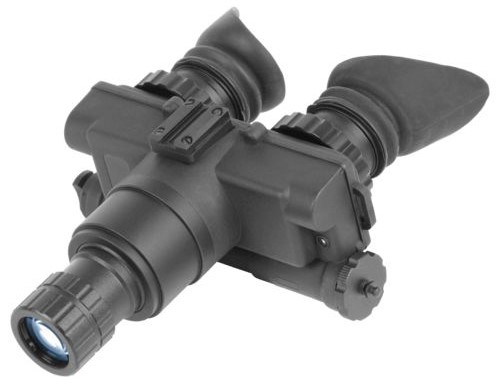
With the basic physics under your belt, let’s get to night vision goggle optical designs, how they work, and what to look for.
Monocular Goggles
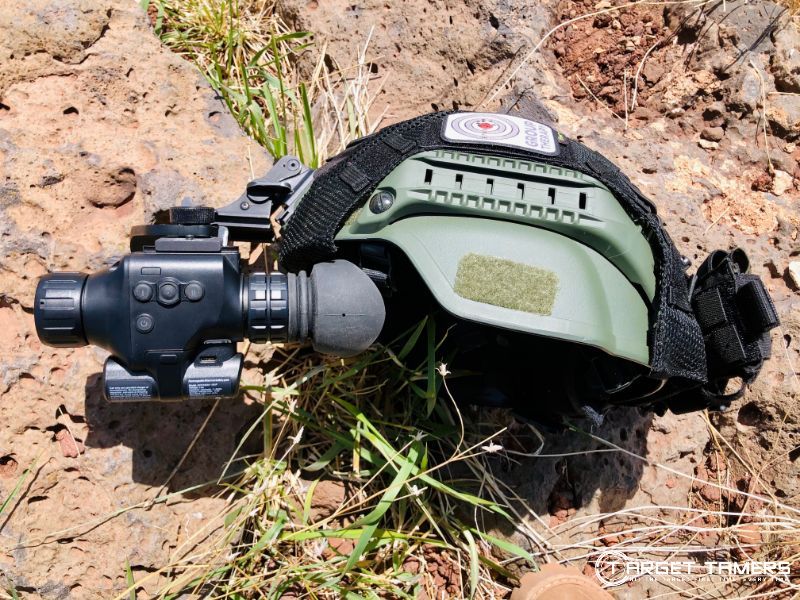
With only a single IIT designed for one-eye-use, the monocular is an affordable goggle alternative. With the one tube, you can reduce the expense of having two IITs, lenses (oculars and objectives), and the housing required to make a night vision binocular. In this fashion, monoculars are speed optics and made for fast, convenient use.
Many like to mount a monocular to helmet/head assemblies for multiple reasons that include:
- Affordability
- Wide fields of view
- Allows for one-eye-use
- Lightweight
- Compact
One of the major benefits of helmet-mounted night vision monoculars is the one-eye-use. What you are doing is keeping both eyes open with one eye looking through the device while the unaided eye maintains both dark adaption and some peripheral vision.
When the eye looking through the monocular is experiencing fatigue, you can switch the monocular to the other eye and provide both relief and extended observation benefits.
The PVS-14 is a great example of such a monocular used in the goggle fashion. With no magnification, hands-free operation, and a small aperture, they can be excellent goggle alternatives.
Biocular Goggles
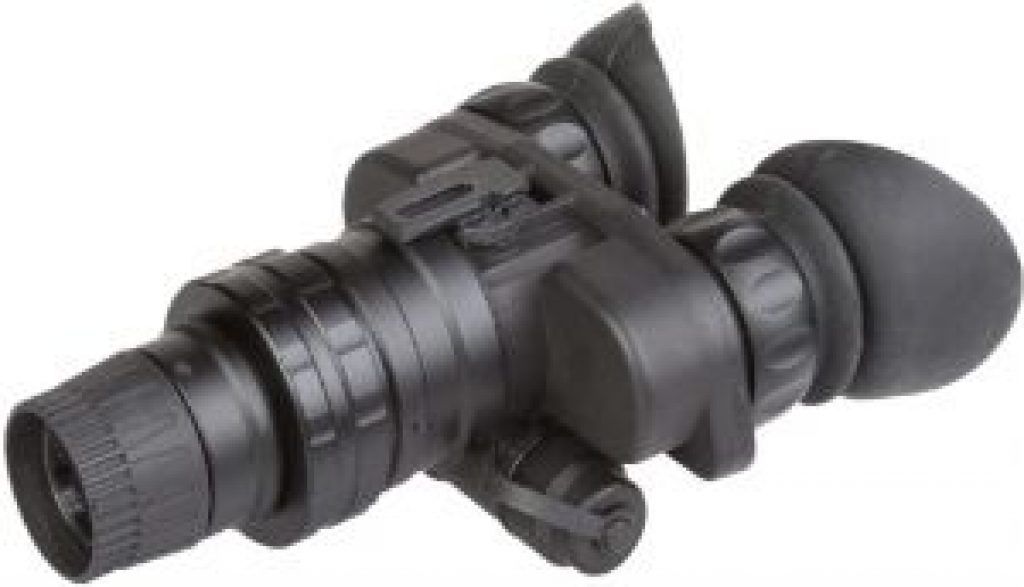
You may not have heard the term biocular before. It looks similar to a binocular except it has one objective lens and two ocular lenses. In this case, the biocular has a single IIT that allows for the same image to be shared between both eyes.
So, while you have a single tube with all the necessary night vision electronics and components working to provide night vision, once the photons are released from the phosphor screen, they’re focused by two eyepieces. One IIT and two eyepieces.
While bioculars have better depth perception than monoculars, they fall behind the dual tube design of binoculars. Bioculars also come with magnification, so for it to be appropriate for goggle use, they must not have magnification.
Key features of biocular goggles:
- 1x magnification
- Hands-free use
- 1x objective lens/2x ocular lenses
- 1x IIT
- Can be lighter than binoculars
- Better depth perception than monoculars
An example of the biocular design incorporated for goggle use is the NVG7 that has 1x magnification, 26mm lens, adjustable IPD, included head mount with flip-up gear, and a single IIT.
Binocular Goggles
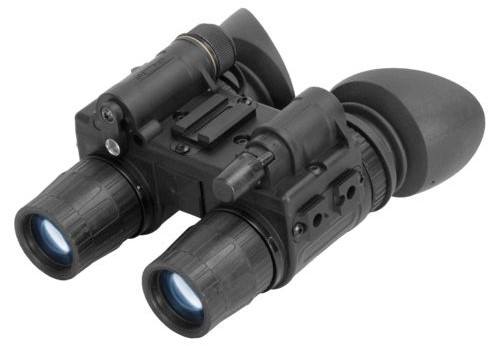
The key to identifying good night vision goggles when looking at a binocular optical design is to first identify its magnifying power. It’s very likely that with 1x magnification they’re designed for hands-free operation to be used and classified as goggles.
There are too many disadvantages of using magnified binoculars as goggles – don’t do it. Magnified binoculars are excellent for stationary observation either with handheld operation or tripod mounting.
- Pro Tip: Combining high power with a low performance IIT will negate most of the magnification benefits. Magnification isn’t everything.
The benefit of using a 1x magnification night vision goggles is that you have two IITs working to provide an image to suit two-eye operation. This is called stereo vision where both eyes are being provided an individual image. These should have an adjustable IPD (interpupillary distance) to acquire the best visionary experience. Some goggles allow for independent flipping-up of either tube.
Because of the stereo vision benefits, depth perception, navigation, and mobility are improved versus the single tube of a biocular and monocular. The downside is weight and cost, and they’re not adaptable to other mounting methods like on weapons or to other optics.
Key features of binocular goggles:
- 1x magnification
- Hands-free use
- 2x IITs
- Stereo vision
- Depth performance
- Mobility/navigation
The PS15 gives you a great idea of what binocular goggles should look like with its 1x magnification, 27mm lenses, and dual tube design.
Fact or Fiction? Common Night Vision Goggle Complaints
If you understand the tech, you’ll see that some complaints are legitimate while others can be prevented. Have you been guilty of these grumbles?
Goggles are Heavy
Goggles should be lightweight enough to comfortably mount to your helmet. Unfortunately, they haven’t always been, and if mounting goggles has felt like strapping a tank to your temples, this couldn’t be truer for you. Forget trying to navigate your way through pothole terrain or ditches with a lop-sided or sagging piece of gear on your head, right?
These days, there isn’t much of an excuse to have goggles weigh in at more than two pounds as they are coming in lighter. They’re still heavier compared to a lighter-than-one-pound monocular. Waiting for manufacturers to keep up with the ultra-lightweight trend is a work in progress.
Fact or Fiction: Fact
Goggles are Battery Hogs
Having to carry spare batteries is another thing to think about and tack onto your person or stash in your pack. If you left them in the truck that is parked a mile away, it’s a lesson to you. It comes as no surprise that NVDs can be battery hogs.
Digital devices are bottomless pits, but image intensifier tubes have better battery life performance with some lasting as long as 60 hours on a single CR123A or AA battery. Depending on what year you last used night vision goggles or if your only experience is with digital devices, 40-60 hours is pretty good from an IIT.
Fact or Fiction: Fiction
Goggles Need Light
Ya need light – that’s a given with night vision. Yes, you’ll be extremely limited under thick forest canopies or when heavy cloud coverage threatens precipitation of various kinds. If you’re a black cloud of your own, then every night you head out with goggles is a night like this.
Regardless of the limitations that are out of your control, it’s a fact that night vision requires at least some light, even if it’s minimal. Putting aside the special demands of law enforcement or military, use an IR illuminator – it’ll do you wonders. Since we all know that night vision isn’t thermal, there’s no point in complaining about its inherent incapabilities.
Fact or Fiction: Fact
Non-operable in Unnatural Light
Yes, the sun is natural, but it’ll destroy your goggles. Damage can occur from very bright artificial light too. It would have to be extreme because the most people get from bright light sources like car lights, streetlights, flashlights, etc., is a blooming and washing-out effect. This causes you to lose contrast, sharpness, and usable details for identification.
However, the best night vision goggles come with tubes that can handle and mitigate the effects of bright lights. We’re not talking about automatic shutdown to protect the tube but autogating and unfilmed/filmless features to prevent these annoying drawbacks to bright light sources. Since there are many NVDs with high-performance tubes to help deal with these issues, this myth is busted.
Fact or Fiction: Fiction
FAQs
Short answer: no. Both digital and IIT night vision goggles require light to provide vision in the dark.
In total darkness, extremely cloudy nights, during fog and rain, etc. night vision performance is impaired. You will need to incorporate IR devices to assist NV technology. However, IR devices are visible to other NVD users, so they are not appropriate for covert applications. Thermal imaging goggles do not require ambient light and can be used in total darkness.
Bright light sources cause the IIT to be overwhelmed by photons and the result is an incredibly bright image with effects often referred to as blooming, flooding, haloing, etc. This will either cause vision sensitivity, no usable image, and/or the automatic shutdown of the goggles. Many NVDs are equipped with a bright-light cut-off feature to protect the tube from damage from bright light sources.
Neither night vision nor thermal imaging devices allow for detection past or through walls. Obstructions such as walls, trees, houses, smoke, fog, rain, snow, etc., will impair night vision performance.
However, thermal goggles will perform better in smoke, fog, rain, etc. because infrared wavelengths are long and can easily be detected, and they do not require light to function.
Separate Night Vision Fact from Fiction
Now you know that movie you watched where night vision goggles “saw” through walls was all for cinematic theatrics. It’s not real.
Now you know the ups and downs of how night vision goggles work and what it means for your intended applications.
Now you know how to shop for goggles having been armed with the know-how to get it done the informed way.
Now you know fact from fiction.
Further Reading




